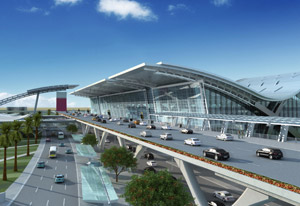Last year was a landmark for Qatar Airways. Only 14 years after its launch, the airline took delivery of its 100th aircraft and launched its 100th route. However, 2012 promises to be even more significant, with its first Boeing 787 due to arrive in time for the Farnborough air show ahead of launching on the London Heathrow route, and the 42-gate new Doha International airport - with an initial capacity of 28 million passengers - opening by the end of the year.
The airline's pace of growth under energetic chief executive Akbar Al Baker continues to impress. Throughout 2012, its route network will expand to about 120 cities, while - with commitments for roughly 250 airliners, including options - Airbus and Boeing jets will join the fleet at a rate of more than one a month during the next several years. The airline, which employs a total of 1,800 flightcrew, needs to recruit 750 pilots this financial year, a mix of direct-entry captains, first officers and "fast-track" second officers.
 |
|---|
© Qatar Airways The narrowbody captains that Qatar Airways recruit must have 6,000h flying time, while widebody counterparts require 7,000h |
But despite the challenge of filling the cockpit seats on its fleet of mainly Airbus A320s and A330s and Boeing 777s - with 787s and Airbus A350s and A380s to come - Al Baker insists the airline will not relax its stringent recruitment standards.
"We will delay delivery of aircraft if necessary if we cannot find pilots with the quality we require. That will never be compromised," he says. Until now, he adds, the airline has not struggled to find the right standard of applicant because industry downsizing and airline closures have kept the pipeline supplied, especially with young ambitious pilots let go because of their place on the seniority pecking order.
Although the speed of its expansion means Qatar Airways continues to recruit direct-entry captains for both its widebody and narrowbody aircraft, Al Baker believes nurturing young pilots in the culture of the airline is vital. The carrier runs a scholarship programme for young Qataris, sponsoring ambitious youngsters to train as second officers, and plans to open this to foreign citizens. In a small country where native Qataris make up only a fifth of the population, this is a necessity to bring new blood into the airline, says Al Baker.
 |
|---|
© Qatar Airways The new Doha International airport will replace a much smaller version in December |
Al Baker - who joined Qatar Airways when it relaunched as an international carrier in 1997 - has also spent that time putting Qatar Airways on the map. Passenger numbers have increased fivefold to 16 million in the past five years, during which the fleet has grown from fewer than 30 aircraft. He has made a name for himself thanks his unstinting commitment to high standards - as witnessed by the airline's industry-leading premium cabins and airport lounges - and no-compromise approach to his suppliers if they fall down in their promises: he is not averse to humiliating them in front of the world's media at a major air show.
The airline is often compared to Emirates, but there are marked contrasts between the two airlines and the contexts in which they have prospered. Unlike Emirates, which had a decade head start on its rival, Qatar Airways has not had the benefit of a thriving domestic tourism market and has had to rely much more on transit traffic. Qatar Airways has used a mixed single-aisle and twin-aisle fleet, whereas Emirates has stuck to widebodies. And, finally, while Emirates has the advantage of a giant dedicated terminal at Dubai International, Qatar Airways has struggled with a small and cramped hub airport, with passengers bussed to and from aircraft.
However, from next year that final problem should be remedied when the two-runway 2,200ha airport opens on largely reclaimed land 4km east of the existing airport. Al Baker says the airport - "the most sophisticated in the world" - will improve the way Qatar Airways operates by "leaps and bounds". He admits that, until now, while Qatar Airways offered a "very high standard of in-flight services, ground services were very stretched and this has affected the traveller experience".
From the middle of this year, Qatar Airways pilots - or at least those qualified to fly Boeings - will have the chance to pilot the newest airliner in the industry. The airline plans to buy 60 787s (including options), with five Dreamliners joining the fleet this year. From next year, their Airbus counterparts can aspire to the world's largest airliner, the A380. Qatar Airways is ordering 10 (with three options). Shortly after, the Dreamliner will be surpassed by a newer type, the Airbus A350 - Qatar Airways has no fewer than 80 on order, including options. One of the biggest advantages of working for the airline, it says, is flying one of the youngest fleets in the world.
Pilots who do not want to fly Airbus or Boeing airliners on scheduled flights can opt for a very different cockpit job. Qatar Airways moved into business aviation in 2009 with its Qatar Executive spin-off, operating a fleet of six Bombardier Challenger and Global aircraft and tapping a market of high-net-worth individuals prepared to pay much more than a first-class fare for the convenience of private, on-demand flights. Despite the regional sluggishness after the Dubai financial crisis, Al Baker says the business has got off to a flying start and he is looking to expand the fleet with newer Global 7000 or 8000 jets or with large-cabin types from Gulfstream or Embraer.
Source: Flight International



















